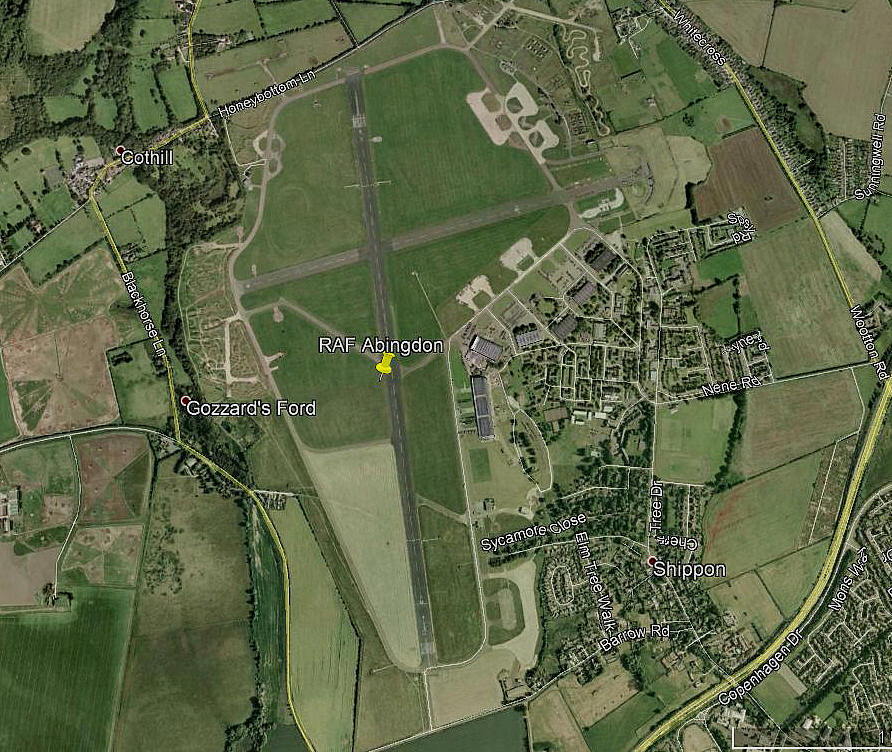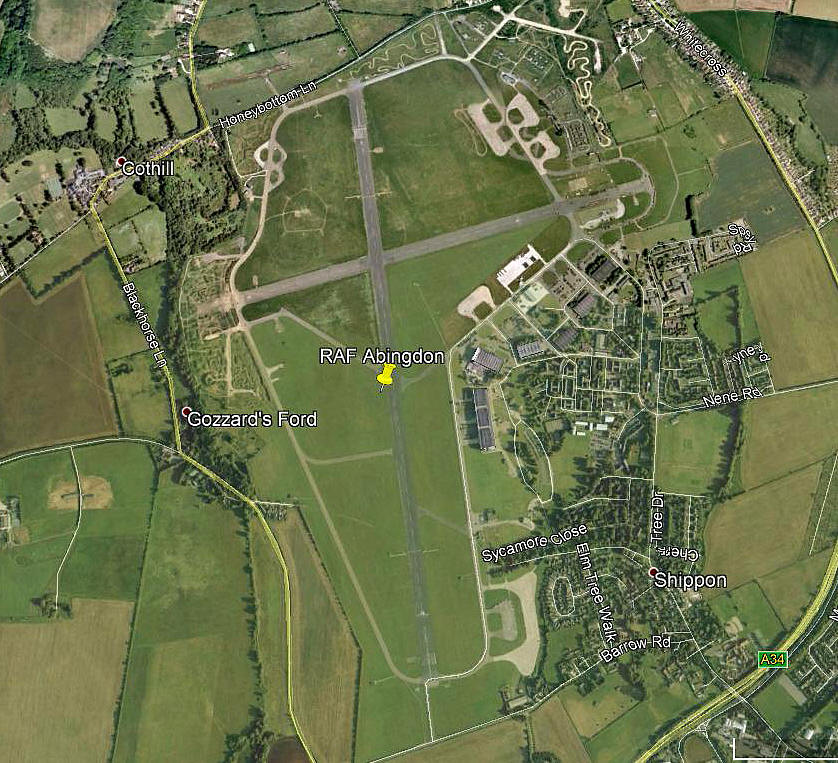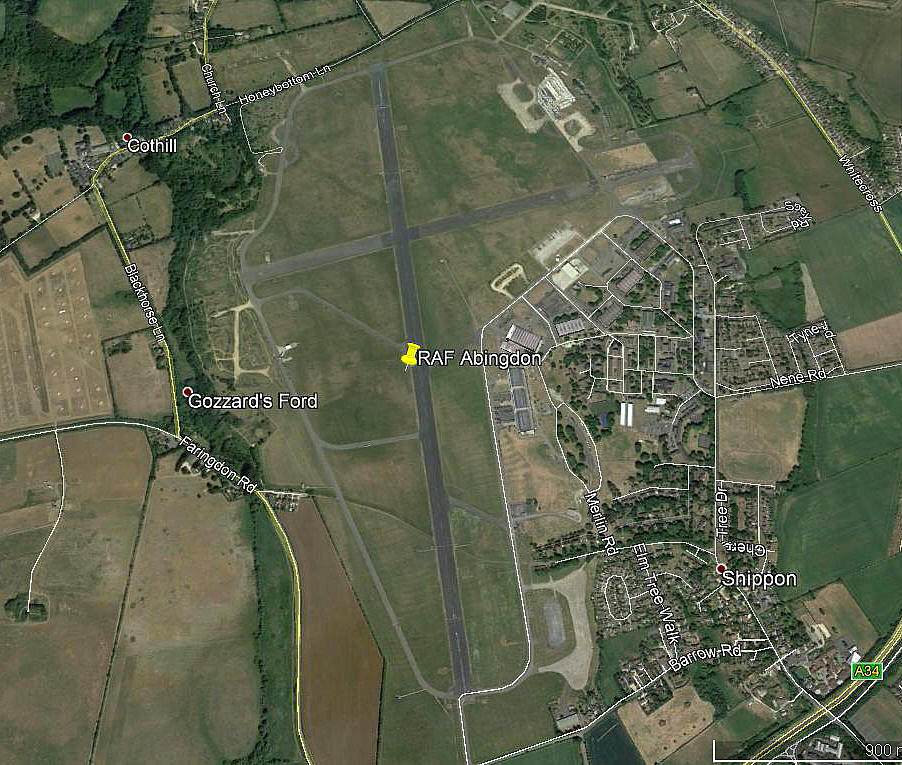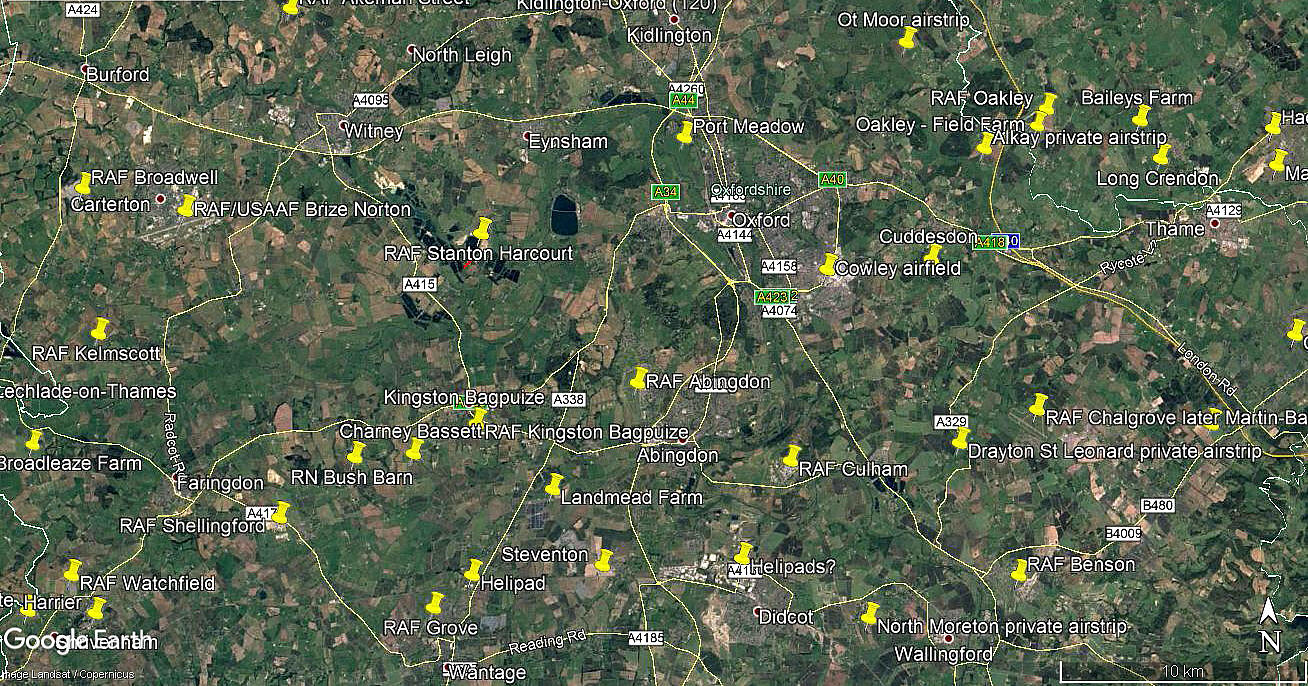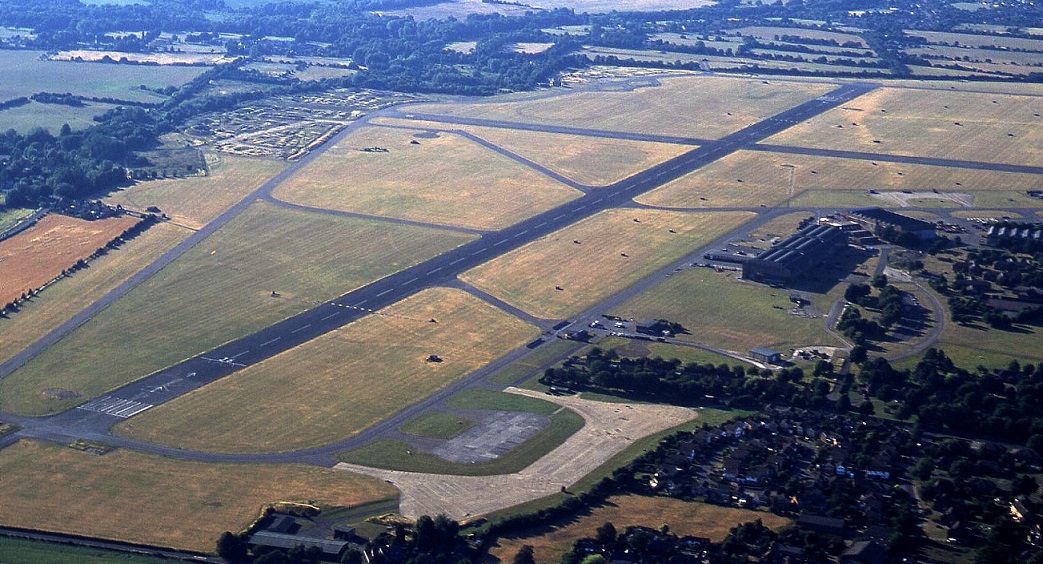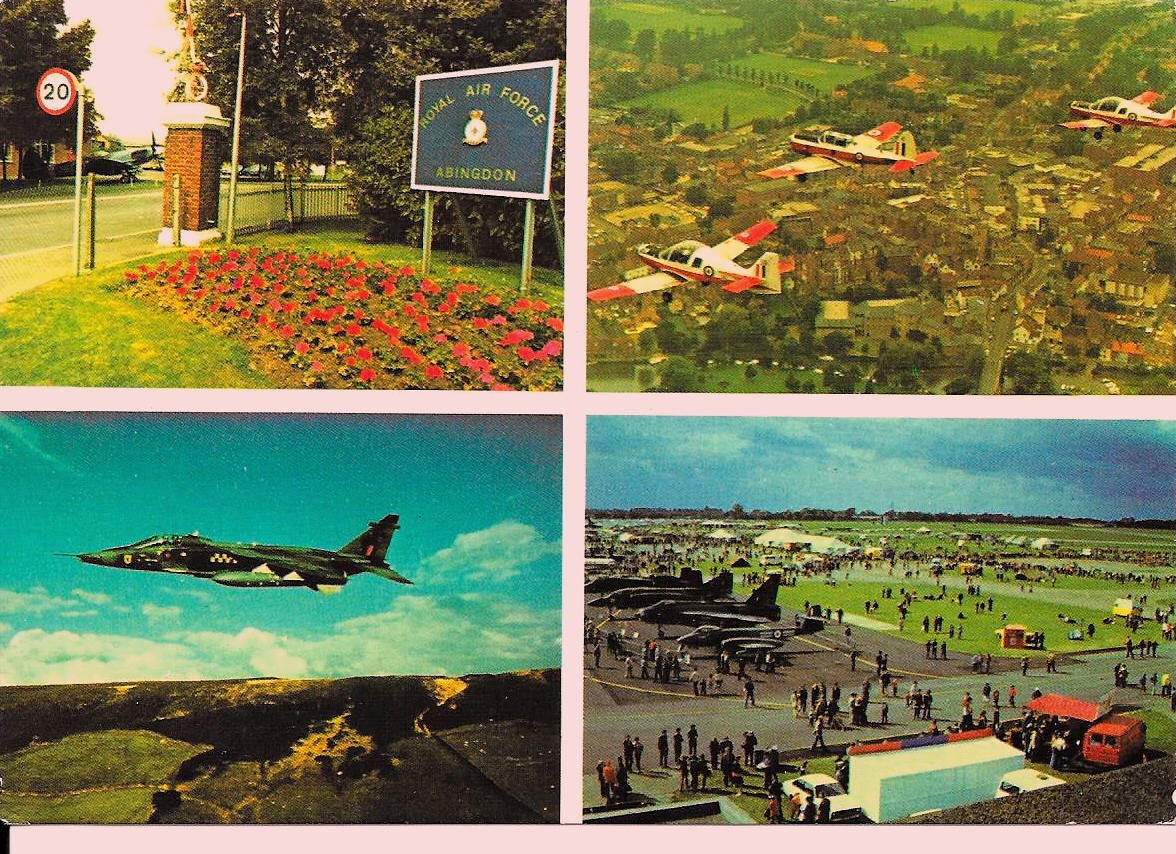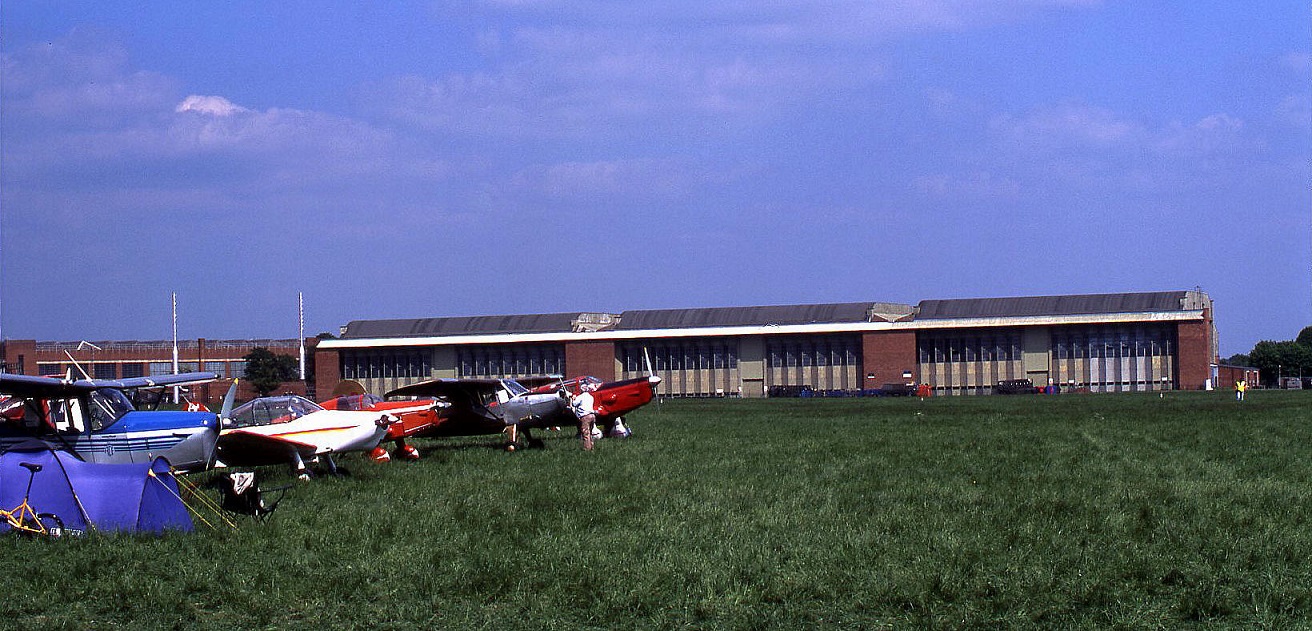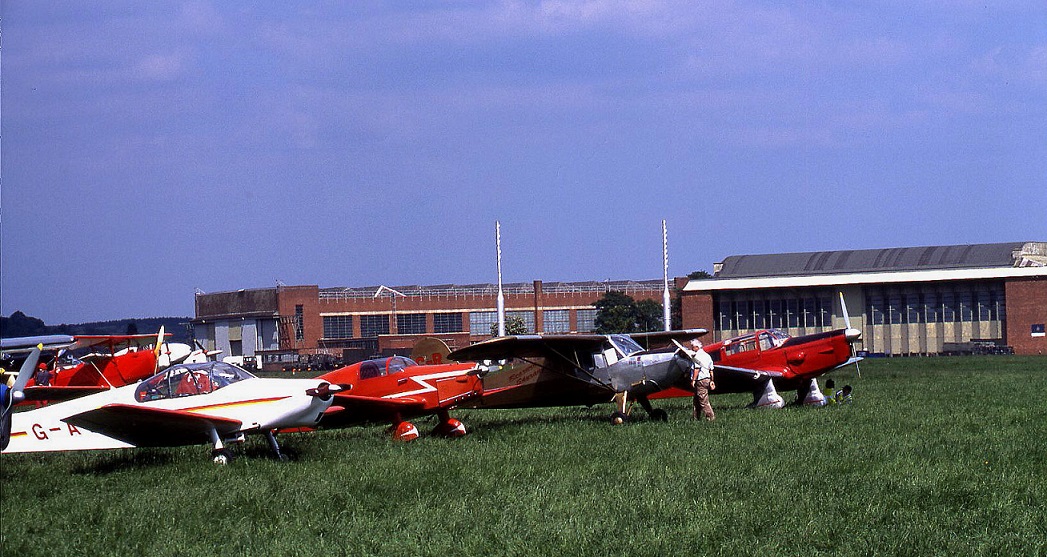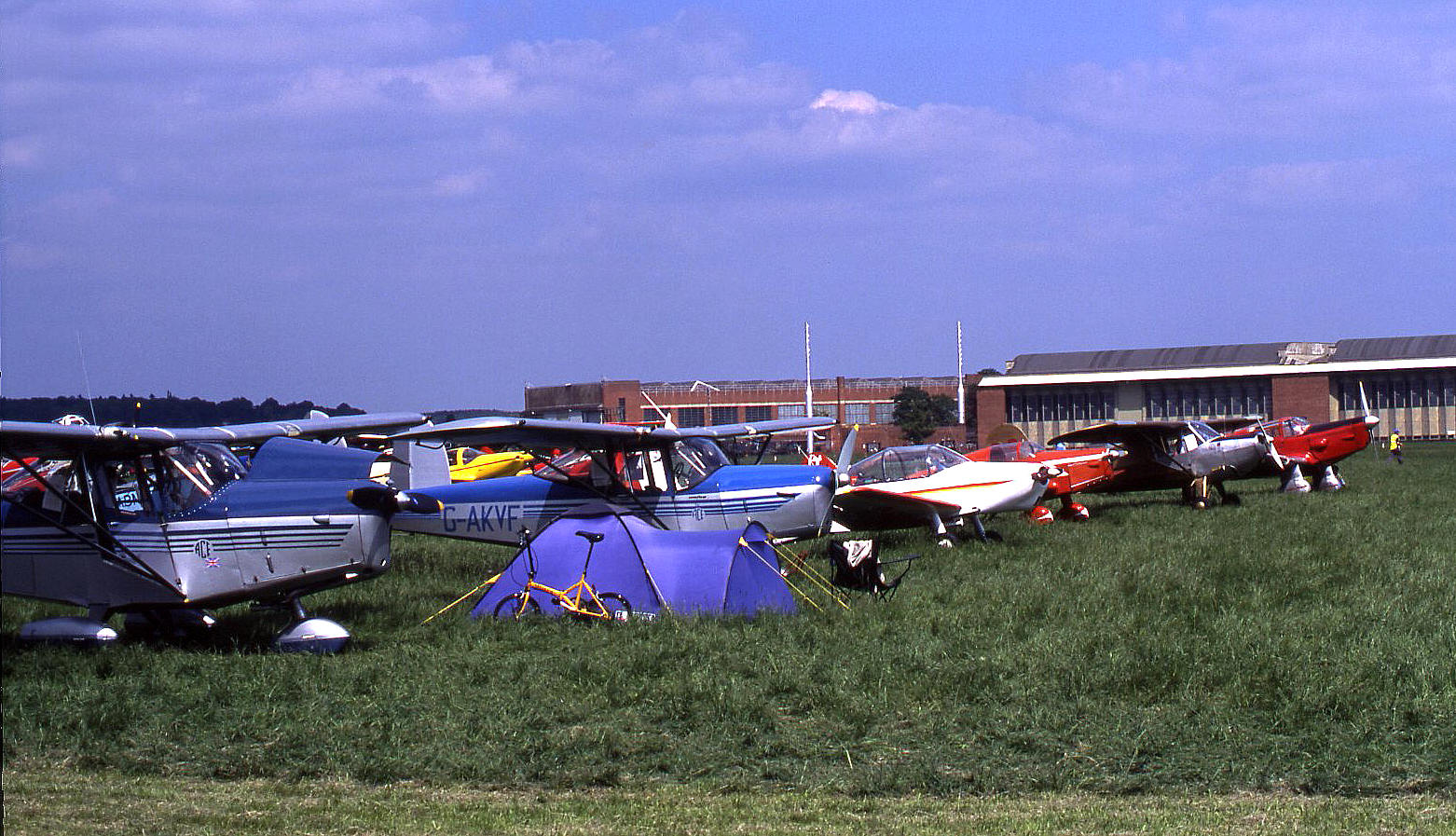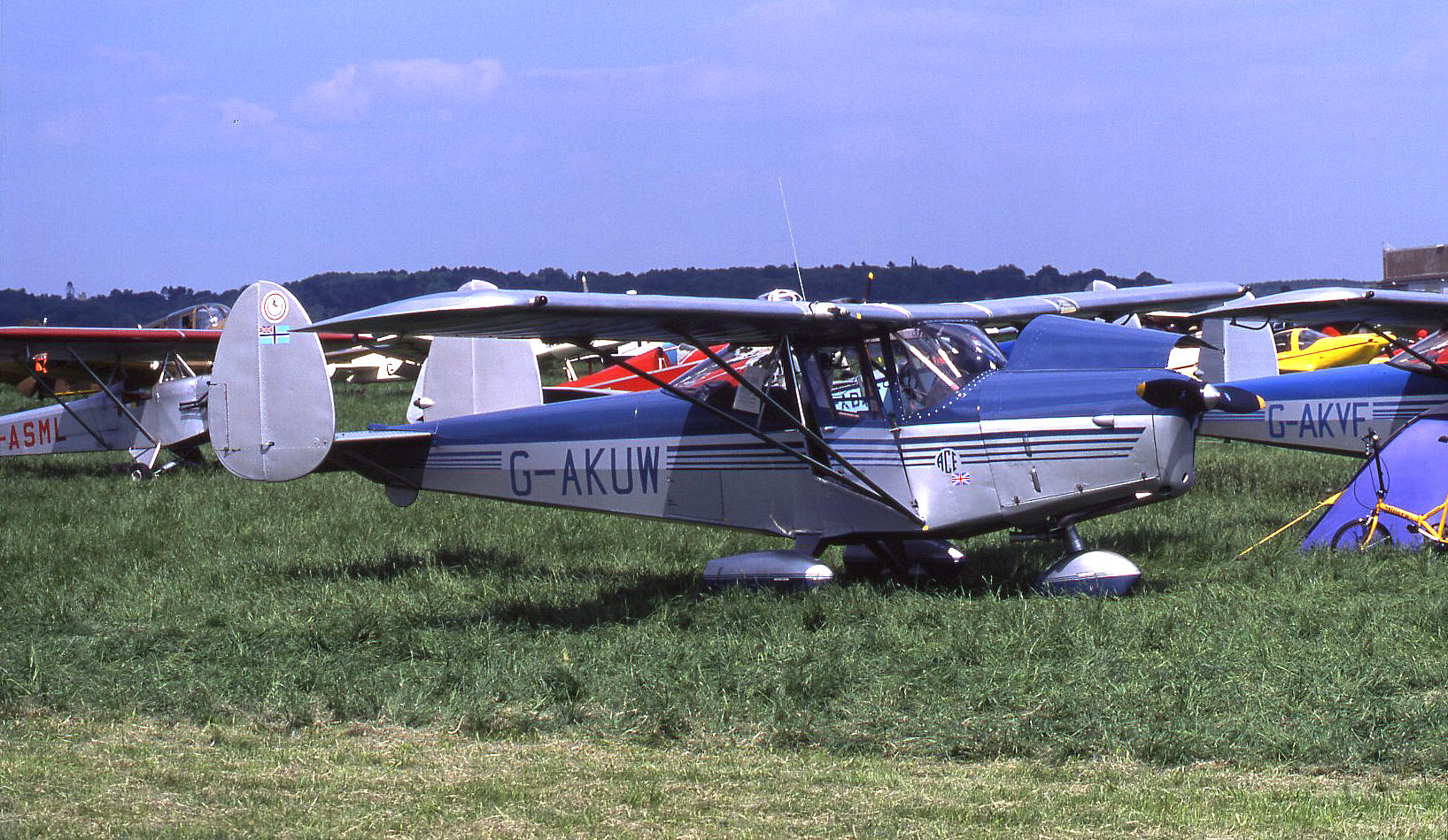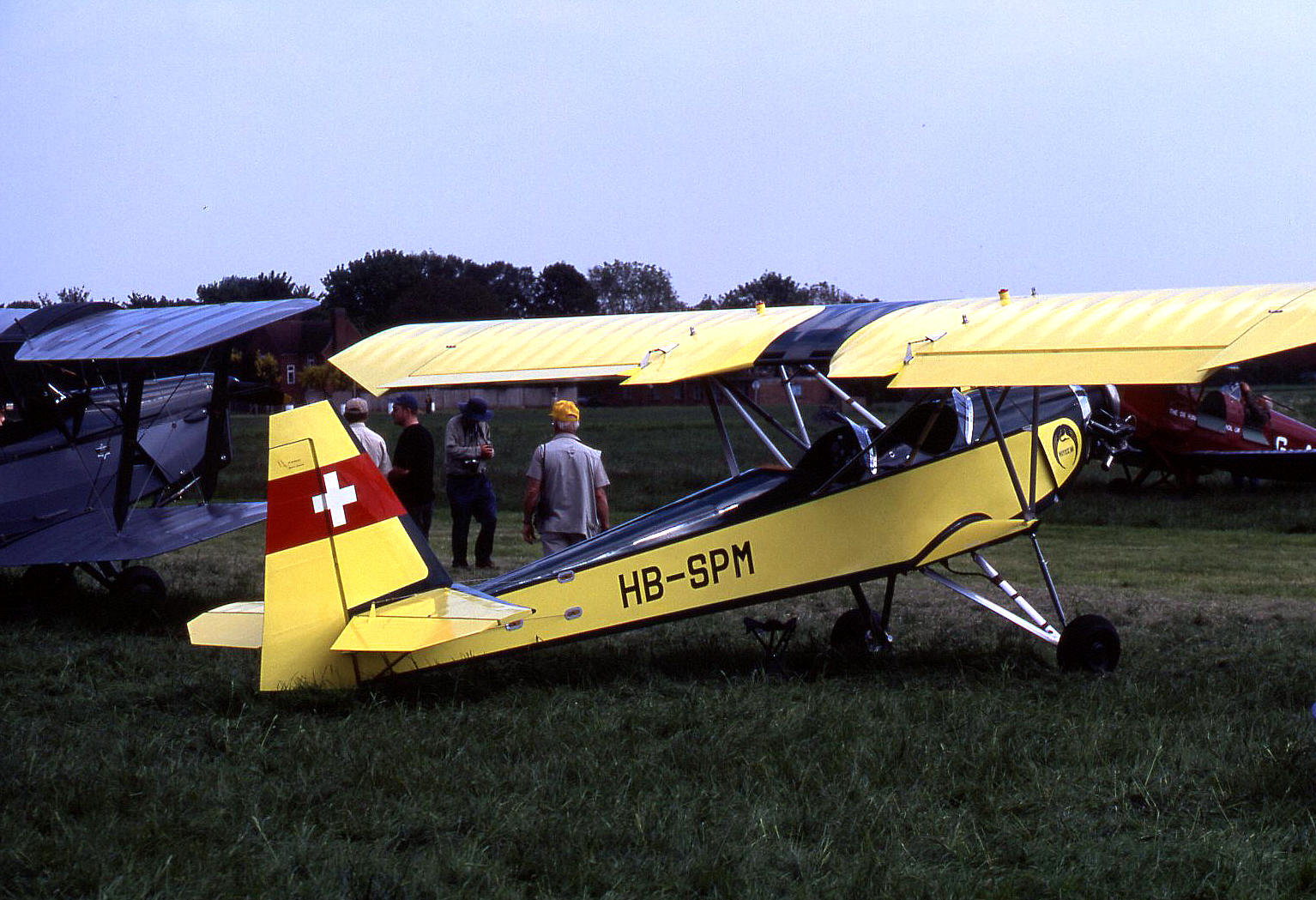Abingdon
ABINGDON: Military aerodrome
Note: All four of these pictures were obtained from Google Earth ©
Note: Pictures by the author unless specified.
Military users: 1919 to 1940:
RAF Bomber Command I Group
15 Sqdn (Hawker Harts & Hinds, later Fairey Battles)
62(B) Sqdn (Hawker Hinds)
103 Sqdn (Fairey Battles)
106 Sqdn (Avro Ansons, Fairey Battles, Handley Page Hampdens & Hawker Hinds)
WW2: RAF Bomber Command OTU Group
10 Sqdn (Armstrong-Whitworth Whitleys, Vickers Wellingtons & Handley Page Halifaxs)
52 & 63 Sqdns (Fairey Battles)
91 Grp Comms Flt 10 OTU (Avro Ansons),
103 Sqdn (Battles) 106 Sqdn (Avro Ansons & Handley Page Hampdens)
Note: These pictures are from a postcard kindly sent to me by Mike Charlton who has an amazing collection: see www.aviationpostcard.co.uk
The first picture is interesting because, in the mid-distance beyond the entrance, the Spitfire MKXXII PK624 can be seen. An aircraft with a long and complicated history. Built at CASTLE BROMWICH in 1945, after active service it appears that it first became a 'gate guardian' at NORTH WEALD, then RAF UXBRIDGE before being placed at ABINGDON from 1970 until 1988/89.
Post 1945: RAF Training and Transport Commands 1 LRFU
242 Squadron (Vickers Wellington, Short Stirling, Avro York & Handley Page Hastings)
Note: Did 242 Squadron fly all these types from ABINGDON?)
10 OTU (Operational Training Unit) (Vickers Wellingtons)
London UAS (Beagle Bulldogs), Oxford UAS (Bulldogs) & 6 AEF (DHC.1 Chipmunks)
Note: I have found records of Vckers Valettas and Handley Page Hastings being used for parachuting training, and Blackburn Beverleys. Can anybody kindly offer advice?
Flying Club: No.47 Sqn. Flying Group
Note: In the 1957 The Aeroplane directory, No.47 Sqn. Flying Group operated one DH82A Tiger Moth, and membership was restricted to No.47 Sqn. personnel.
Gliding: 1997: Army 612 VGS (Also, gliding listed in 1975)
Motor gliding: 2000s only?
Civil users: Post 1945: On MoD contracts: ACE Freighters, Air Charter, Jersey Airlines
Location: W of B4017, SSE to SE of Dry Sanford, NW of Abingdon
Period of operation: Military: 1925 (some say 1932) to 1992 (although still used for UAS/AEF motor-gliding up to
2004) (Status since 1992? Care and maintenance perhaps?)
Runways: WW2: Up to 1944 this was apparently still a grass airfield with maximum landing distances of 1463 E/W and 1829 N/S, pretty much identical to the hard runways
Late 1944 or even 1945? 01/19 1830x46 hard 09/27 1465x46 hard
1955: 08/26 1463x46 hard 18/36 1829x46 hard
1990: 08/26 1463x46 hard 18/36 1991x46 hard
NOTES: In his excellent book ‘Taking to the Skies’ Graham Smith claims that on the 4th September 1936 Jean Batten took off from here in a Vega Gull, ‘The Messenger’ VP-KCC loaned by Lord Carberry. This is one of very few serious errors found in this excellent book, (I only wish the same can be said for my jottings!). In fact the pilot was Ms Beryl Markham who, about twenty-two hours later (some say twenty hours) crash-landed in Nova Scotia due to engine failure. I now know that without much doubt she had run short of fuel. The original plan was for a flight of 16 to 18 hours duration, to New York, with ‘adequate’ reserves. However, the headwinds were greater than forecast and, from her own account, the engine eventually failing then picking up again, several times in short succession, are classic fuel starvation symptoms.
She thereby became the first person to fly solo across the north Atlantic from east to west from England. Jim Morrison had of course flown across previously, but he’d taken off from Ireland. Why she elected to depart from ABINGDON I can’t find an explanation for, as surely, somewhere like RENFREW for example would have been a better choice, giving at least an hour or more of extra range on the other side? But, this would have meant taking-off from Scotland which in those days wouldn’t have counted for much, (of similar status to Ireland?), as it had to be from England - it appears that Lord Carberry had insisted on this.
It has to realised today that for most people in the UK and in the Commonwealth countries it was England that really counted at that time. Indeed, when WW1 commenced several if not most accounts state that ‘England’ declared war on Germany. The simple fact that Scottish, Welsh and Irish (from both north and south) men decided to totally support England and if anything, suffered disproportionate losses – needs to be remembered. Added to which, in the trench warfare regime, soldiers from the Commonwealth countries were often viewed as being ‘cannon-fodder’ and of no account. Often slaughtered in their thousands on utterly hopeless offensives which had absolutely no chance whatsoever of advancing the war.
BERYL MARKHAM
Beryl Markham is yet another extraordinary female pilot from this remarkable era ‘between the wars’ and her autobiography West with the Night is highly recommended and perhaps her decision to use ABINGDON might be explained? Yet another book to add to my list of books ‘which must be read’ that seems to increase daily! In 2012 I discovered another aspect about this flight quoted from West with the Night. Before departing from ABINGDON she had flown across from ELSTREE in a lent or hired aircraft.
In his excellent biography, Amy Johnson - Enigma in the Sky, author David Luff adds more detail. It now appears that in fact Jim Mollison, by then Amy's husband, had flown Beryl across from ELSTREE in a hired Puss Moth and had tried to dissuade Beryl from leaving that day as the weather was really not too good. "Just before she climbed onto the wing of her aircraft in the late afternoon, he unstrapped his gold watch, the one he had used on his own Atlantic crossing in 1932, and handed it to her with the wry comment, 'Here Beryl, don't get this one wet.'
On crash landing she had been awake for forty hours! Much of the actual flight flown on instruments, no auto-pilot of course, and in the dark.
OXFORD UNIVERSITY AIR SQUADRON
At some point, early in the research for this Guide I found: “In late 1925 it appears the UAS Oxford Sqdn was formed here.” In fact it was formed in Oxford itself with their HQ in Manor Road. Pretty soon a ‘hangar’ at been erected in Manor Road for ground instruction, a later a lecture room. This has given some the impression that they had an aerodrome at Manor Road, but in fact the flying (mostly at weekends) was done at UPPER HEYFORD (OXFORDSHIRE) where they had Avro 504Ns initially.
Between 1926 and 1938 summer camps had been held at MANSTON and EASTCHURCH in KENT, and FORD in SUSSEX. When the Oxford UAS moved here from UPPER HEYFORD in 1932 it is reported they had one Armstrong Whitworth Atlas and five Avro Lynxs. In fact these were Avro 504Ns powered by the Lynx engine. In 1934 Avro Tutors were introduced. At a summer camp at FORD in the late 1930s it is reported they had three Hawker Harts, two Hawker Hinds, one Hawker Audax and fourteen Avro Tutors to fly. It seems possible that the Hawker types might have been available from FORD – or did they then already have them available here as the country geared up for war?
WORLD WAR TWO
Much has been noted elsewhere in this Guide regarding the very poor bombing accuracy of the RAF, especially when night bombing commenced. In his excellent book Bomber Crew John Sweetman gives this account: “On 7 September, Gerald Dickson finally went to war in a 10 Squadron Whitley – on a short run to Boulogne. When he arrived at Abingdon OTU from Canada in July 1941, his only navigational training had been in an Anson, and he had rapidly to learn the idiosyncrasies of the Whitley. It was, he found, a ‘horribly cold’ aircraft, and ‘very uncomfortable’, especially for the navigator. If someone in the front of the bomber wanted to use the chemical toilet in the rear of the fuselage, he had to fold up his papers to let him pass, ‘a bloody nuisance, and when they’d done what they wanted to do, it started all over again’. In the Whitley, the navigator doubled as bomb aimer, but Dickson doubted the accuracy of the bombsight. ‘I don’t think we hit the target very often’. He was dispirited to think that the crew had achieved ‘so little having flogged all the way to get to the target’.” He was correct - the pathetic failings of the RAF to hit even major targets is described elsewhere in this Guide.
And this comment is added: “Although the ultra-casual approach of the previous year had been abandoned with aircraft now given designated routes and take-off times, (My note; obviously designed to aid the enemy? Read the history to see how true this is), once bombing had been completed aircraft made their own way home. With longer trips this meant approaching the English coast at dawn, which the Germans soon came to anticipate. ‘The Whitley had no prayer in a contest with a lurking Messerschmitt, and we lost a lot of aircraft because they were chopped down in sight of safety’. So here, once again the RAF planners deliberately devised a scheme to aid the enemy shoot down our bombers. There can be no other explanation….surely? Also, they deliberately delayed departures into the night, which was obviously much more hazardous in those days. The enemy would have no idea, (presumably?), of where a raid was headed, or when it was coming. So obviously departing at dusk to arrive over the enemy coast at night stood a better chance? It is another myth that the UK alone had radar, the Germans had it too.
GERMAN RADAR
Referring to an attack by British bombers who suffered very bad losses, John Sweetman says; “What the Germans did not reveal, nor the British realise, was the existence of a Freya coastal radar station which had alerted the enemy fighters. Even when a report was received via Oslo that such a device could detect incoming aircraft at a range of 75 miles, the RAF was not convinced. In December 1939 eight Freya stations were operating along the German coast.”
John Sweetman fills his book with personal anecdotes, alongside an incisive and detailed account of the entire campaign; I highly recommend it. He also adds this interesting detail from the account from Gerald Dickson. “It was with a sense of relief that, having picked up two extra crew at base, in November the crew began flying a Halifax without attending a Heavy Conversion Unit (HCU). For them, conversion training took place under the auspices of 10 Squadron and through a series of local and cross-country practice flights.”
To quote again from Bomber Crew, albeit for the later ‘stream’ strategy, which I have pointed out elsewhere, was clearly designed to aid the enemy and inflict maximum damage to our bombers. This is a German opinion: “The bombers were criticised for sticking ‘rigidly to their course’, which the Germans were unaware had been in their orders. ‘It was a criminal folly on the part of the enemy to fly at 4000 to 5000 metres in a cloudless sky with perfect visibility’.” It was indeed a “criminal folly” deliberately and obviously knowingly devised by senior RAF planning staff amongst whom there must have been Nazi sympathisers. They even made doubly certain that outbound bomber streams, on German targets, heavily laden with bombs and fuel would invariably pass across the most densely populated night fighter bases. Sounds incredible? Check it out, the routes are on record.
ANOTHER MYTH TO BE EXPOSED
It is of course an utter myth that the entire British population (it was more of an English rather than a British war), especially at ‘establishment level’ were opposed to the Nazi regime and declaring yet another war. World War One had ended just twenty years before and the scars and very bitter memories were far from being forgotten. Our Prime Minister may have declared war, but our Royal family was still mostly of German origin. (They changed their name to Windsor at around this time). The trade unions were certainly inclined to create mayhem and mischief to inhibit the war effort. The less scrupulous from criminals to people in business, (both big and small), and some in local government, saw the war as a major opportunity to make a fortune. Without too much doubt, had the Germans invaded, (never a realistic prospect it now seems), many of them would have been queuing up to greet them.
THE OXFORD UAS
According to their web-site the Oxford University Air Squadron were once again based here from 1946 to 1949 but due to 10 OTU being busy, and based here with their Vickers Wellingtons, they also used nearby SHELLINGFORD, which was still active and roughly 2.5nm SE of Farringdon.
A SCHEDULED SERVICE
In the early 1960s at least, BUA (British United Airways), took over a scheduled service for the Atomic Energy Authority, linking HURN (Bournemouth), via ABINGDON to RINGWAY (Manchester). At the time BUA were operating seven Douglas C-47B Dakotas; G-AMYJ, G-AMZF, G-AMZG, G-ANEG, G-ANTB, G-ANTC and G-ANTD. G-AMYJ was flying with Air Atlantique based at COVENTRY until December 2001 when it was de-registered.
A FOND MEMORY
As a teenager on a long cycling and aircraft spotting trip with my very good friend Mike Parker way back in the 1960s we were delighted to see loads of Blackburn Beverleys flying all around and probably mostly practising circuits! Happy days.
ABINGDON HAD AN OBSCURE ROLE IN THE FALKLANDS CONFLICT
The only excuse for including this is simply because I find it very interesting, as it includes several facets of UK aviation history not normally much known about. And, is very much part and parcel of how the RAF’s contribution to this ‘war’ was, in so many respects, very much a hasty and rather botched job – certainly when viewed against normal military procedures. I can highly recommend reading Avro 607 in which the author Rowland White explains in great detail how the four BLACK BUCK Vulcan raids were cobbled together. Mind you, on the other hand I am filled with great admiration for the RAF aircrews and groundcrews who displayed quite remarkable ingenuity, flexibility – and considerable bravery – to pull the mission off successfully. Plus, please remember, nothing like it had ever been attempted before, let alone in such an incredibly short time span.
To quote: “In 1981, faced with rising fuel costs and increasingly stringent airport noise restrictions, British Airways put its entire fleet of fourteen Vickers Super VC10 airliners up for sale. With a number of ex-commercial VC10s already undergoing conversion into aerial tankers, and conscious of the age of its Victor force, the MoD snapped up the old jets and put them into storage. Like the Victors they were equipped with rare Rolls-Royce Conway engines and proved to be a useful and regular source of engine parts. But, with the Vulcan’s desperate need for a navigation system that would be accurate in the South Atlantic, in 1982 the VC10s were ransacked again.”
“The first wave of Victors deploying to Ascension, (My note: The tiny island in the Atlantic from which the BLACK BUCK raids were planned to take place from), had been fitted with the Carousel Inertial Navigation System. If it worked for them, there was no reason it couldn’t also work for the Vulcans. The only problem was that it was needed yesterday. Then someone remembered the VC10s. The Super VC10s sitting outside at RAF Abingdon were fitted with twin Carousel INS.”
“An inertial navigation device is made up of gyroscopes and ultra-sensitive accelerometers. When it’s switched on, it orientates itself to true north. Once aligned, all further movement is detected by the accelerometers and measured relative to that starting point. The beauty of the Carousel was that it was self-sufficient, needing no recourse to any further input. The disadvantage was that it needed at least fifteen minutes to warm up. It couldn’t be hurried. If the warm-up was rushed or the system disturbed, small errors would creep in from the outset. Over half an hour it was probably unimportant, but over a long flight any error grew exponentially. And once an aircraft was airborne the system was impossible to reset.”
A PERSONAL ‘INS’ STORY
Perhaps things have now changed but until recently, in airliners, the INS was a primary navigation aid, GPS a secondary aid. Now then, here is story which I trust might interest you. About twenty years ago I was booked on a Lufthansa flight from Heathrow to Frankfurt, the service being flown by Boeing 737s. Gathered in the boarding lounge we were informed there would be a serious delay. On enquiring what the problem was I was told a INS on the inbound flight had failed, and each pilot had to have a serviceable INS. As the time passed I enquired why British Airways or British Midland, both operating basically the same type, couldn’t provide a replacement INS. I was told they had exactly the INS needed, but the batch numbers, (or something equally ridiculous), didn’t permit fitting their INS to the Lufthansa B.737. Therefore we had to wait for a replacement unit to arrive on the next flight from Frankfurt. I was then told that BAA would be charging Lufthansa £8,000 a minute to for the extra time this aircraft occupied on the gate. On hearing this I was, needless to say appalled, but was informed this was peanuts. In fact it was costing Lufthansa many millions as the entire European operation would now have to be re-organised for the following day.
On the face of it obviously a case of the lunatics running the asylum? Or - is there really a technical issue?
Is it much different today? It was certainly a most dramatic introduction to the commercial realities of running an airline in the late 20th century. I have heard many similar stories whereby mostly the bean-counters (accountants) fail to recognise that aircraft equipment can fail, and having back-up spares available throughout the system is not an option. And, maybe they are correct, given the cost of running such an operation 24/7 365 days a year - but I doubt it..
A PART IN THE JAGUAR STORY
It might seem odd to some, including me, but in the late 1970s and early 1980s, (at least), RAF ABINGDON was a SEPECAT Jaguar Maintenance Unit. It has become a fact of operations that since WW2 military aircraft, by and large, are hugely unreliable and ineffective throughout much of their ‘in service’ life. For every hour flown these modern designs seem to require many hours of TLC costing a fortune.
And yet, in civil aviation airliners, although always becoming ever more complex, are achieving reliabilty standards which really are quite astonishing despite flying a massive amount of more hours compared to most military types. Obviously something has to explained.
THE LONDON TO VICTORIA AIR RACE (1971)
In May 2020 Mr Graham Frost sent me a long list of Berkshire flying sites, which started with a brief mention of this race. Having never heard of it I decided to have a trawl around on the inter-web - to discover it really was a major event, staged to celebrate the centenary of British Columbia becoming a Canadian State in its own right. Fifty-six aircraft entered the race which was held from the 1st to the 7th July.
ROUTEING
The basic routeing was ABINGDON - PRESTWICK - REYKAVIK - NARSSARUAQ - GOOSE BAY - OTTOWA - WINNIPEG - REGINA - CALGARY - VICTORIA (BC). But, clearly, this was only a suggested route.
One entrant for example, routed: ABINGDON - WADDINGTON - LINTON -on-OUSE, LOSSIEMOUTH, then REYKAVICK - GOOSE BAY - QUEBEC - OTTAWA - SUDBURY - THUNDER BAY - WINNIPEG - REGINA - CALGARY - VICTORIA (BC). It seems that three aircraft failed to reach their selected staging posts, at least one ditching - but nobody was even seriously hurt (or so it would seem).
I am quite certain that I have never come across such a diverse range of aircraft taking part in such a major undertaking, ranging from a 1930s Beech Staggerwing to a state of the art Dassault Falcon submitted by the Royal Canadian Air Force. Listed below are some examples in alphabetical order, nearly all of which were privately owned, or by private companies:
From Beech types were the 1930s Beech B17B Staggerwing CF-GWL, WW2 era Beech (18 or C-45) Expeditor 3NM CF-ZOI and Beech 95 Travel Air VH-TKD. (Did it fly from Australia to compete?)
Aerostar - CF-BBA. Probably the first example to appear in the UK, should this perhaps be described as a 'Ted Smith' Aerostar?
The Bellanca 17 Viking 300, N8792V represented that, perhaps unexpected marque.
Britten-Norman had four examples competing. One BN-2A-8 Islander G-AZAX, two BN-2B Islanders CF-AZM and N50JA, and the BN-2A-8 Trislander G-AYZR.
Canadair submitted a CT-44 Tutor jet trainer, CF-OUM
Cessna types ranged from a tail-dragger Cessna 180A N9790B, together with two twin-engine types - the Cessna 310 N4801B and the Cessna 337 Super Skymaster G-AZAV.
Dassault were represented by a Falcon 20, serial 117501, from the RCAF.
The De Havilland Canada type competing was the DHC-2 Mk111 Turbo Beaver CF-UBN.
The Handley Page type was the HP.137 Jetstream Srs 200 G-AXFV.
Without any doubt the rarest entrant was the 1930s Howard DGA-15P CF-NTY.
The were two Learjet 24B examples - N33BK and N321Q.
North American had one example of the WW2 T-6 Harvard IV CF-UZG, which is a somewhat rarer CCF built example.
For Piper three examples entered, two being PA-24-180 single-engine types, CF-PJX and SE-CTD, plus the twin-engine PA-30 Twin Comanche EI-AVD.
Last but certainly not least was the Swearingen SA-226T Merlin IIIA D-IBMG, with twin turbo-props.
On 'the net' I found several books for sale with detailed accounts of the race, but nothing giving details of the overall winner, let alone the class winners.
ARRESTER GEAR?
In 1990 it seems that arrester gear was in place on runway 18/36 at 400m from each end. Why? This obviously supposes that use by Royal Navy aircraft was intended?…but did this actually happen?
SPOTTERS NOTES
In 1997 two GA types were based here, Auster 5 G-ALBK and Jodel D.112 G-AZFF.
VINTAGE AIRCRAFT CLUB EVENT
Venue in May 2004 for the Vintage Aeroplane Club ‘Fly-in’ with up to 400 aircraft or more attending. As said elsewhere, anybody with an interest in, or indeed a love of classic vintage British aircraft, cannot fail to be inspired by attending one of these events. We are privileged to have so many people devoted to spending so much effort, (and money of course), to not only preserving these lovely aircraft, but keeping them flying!
Vintage Aircraft Club Pictures
ANOTHER MEMORY TO TELL
In the January 2025 issue of Light Aviation magazine there was a feature article about Mr Cliff Whitwell and, asked about his first flight, had this tale to tell from which I will extract these parts: "My first annual camp with the cadets, (My note, he was in the Air Training Corps), was at RAF Abingdon at the age of 13. My first flight was in a Hawker Siddeley Andover at night, the pilot was under training, practicing 'circuits and bumps'."
"The second flight was the next day in a Hercules C130 aircraft. This was much more interesting. With about 30 cadets running round the large rear fuselage, it must have caused trim problems for the pilot, as he eventually opened the rear door. This soon caught our attention, and we all sat down!" He also mentions that whilst in the air cadets he flew whenever he got the chance, logging nearly 100 hours in the back seat of a Chipmunk at 9AEF at RAF Church Fenton when he did most of the flying including simple aeros - but no take-offs nor landings.
These sort of opportunities still exist today, to some extent at least. My nephews daughter is in the ATC and in recent years, (around 2023/24), and has had glider flights from LITTLE RISSINGTON, flights in a Grob Tutor including aeros from St ATHAN, plus two flights in an Airbus A400.
We'd love to hear from you, so please scroll down to leave a comment!
Leave a comment ...
Copyright (c) UK Airfield Guide















